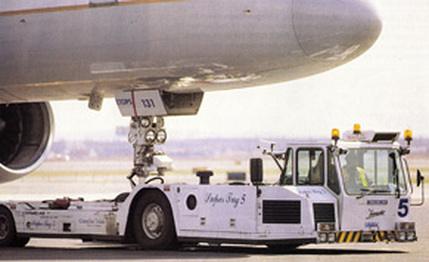 Specialty File
Specialty File
See that Northwest DC-10 over there? As a little joke, let's grab that baby, tow it behind a hangar somewhere, see how long it takes 'em to notice some-thing's wrong."
"I don't think so," replied 31-year-old supertug driver William Jones.
"Come on. It'll be funny. I promise we'll put it back later. Probably."
"No, really, I don't think so."
"Northwest has tortured me for decades. Let's see if they have a sense of humor."
"They don't. Trust me. They don't." At the time, Jones and I were at Newark International Airport, seated within the surprisingly comfortable cabin of a 255- hp, 35,000-pound Douglas-Kalmar TBL-280— a so-called supertug for which Continental Airlines had just shelled out $481,898. It makes as much torque as two Corvettes and can tow any commercial air-craft except a Boeing 747. If Continental needs to tow a 747, it simply fires up one of the TBL-280's big brothers—the 540- hp, 53,000-pound TBL-400. That one costs $667,657.
At airports around the world, conventional tugs are a dime a dozen. They push aircraft away from gates and pull planes a short distance until they're clear of ramp traffic.
A supertug differs in five ways. First, its cockpit is enclosed—heated, air-conditioned, and electrically demisted, in fact. Second, a supertug is in radio contact with everyone—pilots, air-traffic controllers, ground controllers, safety observers, possibly even with Major Tom. Third, a supertug is as simple to drive backward as forward, because its seat and instrument panel swivel 180 degrees. Fourth, a supertug can tow a 660,000-pound Boeing 777 to Akron and back, whereas conventional tugs tend to eat their transmissions after only a few hundred yards. And finally, a supertug doesn't attach itself to aircraft via a steel tow bar. No, sir. Instead, it firmly clasps the aircraft's front tires, then lifts the whole nose gear right off the ground. At which point it can carry a passenger-packed DC-10 forward, backward, in circles, through a slalom, and up to a velocity of 22 mph. In a straight clean-and-jerk vertical lift, the TBL-280 can hoist 77,162 pounds. The larger TBL-400 can lift 99,209 pounds or, if it feels like it, two dozen Cadillac DeVilles.
"Course, I'd never be at max speed with a '10' [DC-10] or a 'triple seven' [Boeing 777] on my back [clasped by the supertug]," says 30-year-old Donald Thomas, who is Continental's manager of supertug operations and a former Navy jet-fighter mechanic. "The port authority has cops out there. You could get a speeding ticket."
Cop: "What's your hurry, son?"
Donald: "I was rushing to catch a plane, sir."
Cop: "Looks like you already caught one. On your bumper there, son. Isn't that an extremely large Boeing product?"
Among domestic carriers right now, only Continental operates this $5 million fleet of British-built supertugs. But that will soon change, because supertugs save money.
"Every time you move an aircraft under its own power," explains Thomas, "you cycle its engines, which decreases the time between tear-downs. If the plane takes 15 minutes to warm up, 20 minutes to taxi to another terminal, and 10 minutes to shut down, then that's 45 minutes off its air life. Also, if you let, say, a 747 move itself— even if it's only 50 yards to an adjacent gate—the fuel it'll burn would probably pay my salary for a week."
There are other economic persuaders at work. Aircraft that are taxiing under their own power must be steered by pilots or specially licensed mechanics, all of whom earn more than supertug drivers. And large aircraft under tow often move more rapidly than under their own power, "because we know the taxiways better than the pilots do," says Thomas, "especially the foreign pilots who have trouble with English."
At Newark, the supertugs act as roll-on/ roll-off flatbeds, picking up dead or idle planes and moving them anywhere on the property. This movement of aircraft is a 24-hour process, starting at 5 a.m., when Thomas arrives. "First thing we do is make sure the RONs are in place," he says, referring to the 50 or so aircraft that "remain overnight" and are the first to depart. After that, the supertugs fetch aircraft from remote locations—those in hangars, for instance, or at U.S. Customs, where planes disgorge passengers but cannot be serviced or reloaded. Thomas tows those aircraft to a terminal a half-mile distant. And finally, the supertugs are used to move aircraft that are broken: "A failed engine, a loss of hydraulics in a steering gear, a flat tire on an active runway—we'll tow those out of the way to get fixed." It is usually only for the latter breakdowns that Thomas and his 50-man supertug crew tow "live craft"—airplanes full of kicking and screaming passengers.